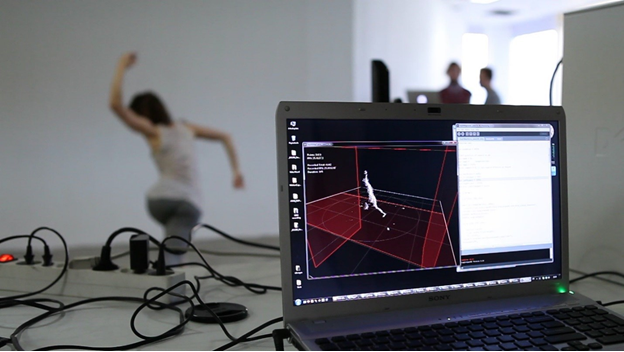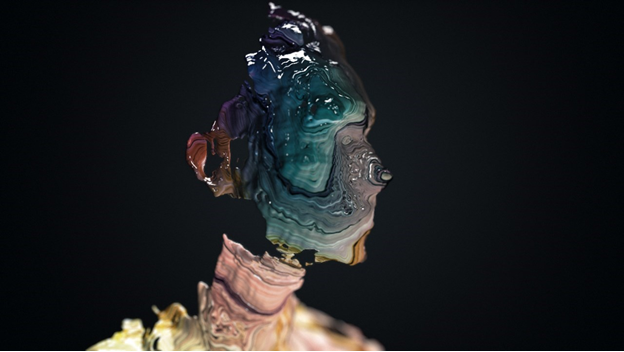Rising changes in technology have deeply modified the way we work, breaking the mold and changing the rules (or expanding them) across disciplines. They reshaped the work of entrepreneurs, lawyers and also artists.
New digital tools have created new alternatives for those who wish to depart from the brush and canvas. Still, combining traditional forms of art such as dancing, with avant-garde technology, Kinect sensors and new editing software, results in never-seen-before pieces.
An outstanding example of how this can be grasped is the Unnamed soundsculpture by Cedric Kiefer and Daniel Franke. Check out their work and our exclusive interview with the artists themselves.
MS: Tell us a little bit about yourselves.
Cedric Kiefer (CK): I work as an artist and designer in Berlin. Together with Julia Laub I founded onformative (www.onformative.com ), a design studio specialized in generative art and design. At the intersection of technology, design and emotion we develop innovative, cross-media solutions.
Daniel Franke (DF): I live and studied in Berlin at the University of the Arts. I work as an artist, Curator and Music Video Director. I’m also one of the founders of LEAP (Lab for Electronic Arts and Performance – www.leapknecht.de) a nonprofit space that tries to create the dialogue between Art, Science and Technology. Our main focus is the experimental research of new tendencies in digital Media and technology regarding the human body.
MS: How do you think digital tools are shaping the work of contemporary artists?
CK: Not the use of digital tools in general is what excites me, but the fact that we are finally able to develop our own tools. Existing software often restricts implementation possibilities and can even predetermine solutions by dictating what can be done with these possibilities. By writing our own software we break through such barriers and simultaneously create new ways of working.
DF: I think they have a big influence on how works look and have been developed. Tools are becoming more and more open and diverse. Almost everything can be produced by yourself, especially with 3D printers or CNC’s. It gives us as Artists the possibility of working with any material, technique or surface.

MS: What was the starting point for Unnamed Soundsculpture?
CK: A lot of our projects, like this one, are self-initiated and experimental. It is an important part of our daily work. Provoked by our curiosity, we are always in search of new forms of expression. We gain abundant experience from our experimental work, enabling us to apply new and unconventional methods of design in our upcoming projects. Most important is to keep being curious about new technologies in this case for example the Microsoft Kinect. Taking the time to take a closer look and even test out the possible boundaries.
DF: For this work we tried to actually use the human body to visualise sound and record it while performing in three dimensions to create a moving digital sculpture that is connected to a certain sound.
In addition to that we wanted to capture the emotions that the performer puts into her movements to add this specific aspect to the digital visualisation of sound – something that you can’t program – raw, unpredictable, arbitrary, irrational – In a sense non-digital to combine it with a strong digital visual created out of raw data.

Also the idea of creating a moving video-sculpture was important from the beginning. Something you can look at from different perspectives to get a feeling of dimensions and space. The work is thereby produced in a way that we can easily change the way these camera moves. The used path is just one of many possible, like how different viewers would look at a sculpture or in a way you would navigate around an object in a 3D-Program.
MS: Is it the first time you use Kinect for your work?
CK: At onformative (www.onformative.com) we have been using the Kinect for several projects in the last few years since it came out. It actually became one of the crucial elements in our project when it comes to user interaction.
DF: Yes – I had this idea for a while and was also considering to use another depth camera. But as the kinect came out and was hacked – it was the perfect option for our project – also in terms of budget.
![kinectandart3_Thumb[1]](https://news.microsoft.com/wp-content/uploads/2015/03/kinectandart3_Thumb1.png)
MS: Have you tried other kinds of media before going into digital art?
CK: No, I actually started to work with digital tools from the beginning. What is important though is to collaborate with artists from other disciplines to learn from and get inspired by their way of working
DF: I was working a lot with Video/Film and Graphic Design. I also have a theoretical background that I try to combine with my practical work – I like the idea of having these two fields correlating to each other – researching a specific aspect of my work and put it in a broader context.
![kinectandart5_Thumb[1]](https://news.microsoft.com/wp-content/uploads/2015/03/kinectandart5_Thumb1.png)
MS: We’ve noticed your presence through a social media channel. How do you think artists can benefit from using this sort of communication?
CK: Social media definitely became a powerful way to promote your work and gives you the chance exhibit your work to a larger audience. Even as a young designer working at home your work can be seen by people from around the world. Something that wouldn’t have been possible just some years ago.
DF: It is a great tool for artists, especially if you are unknown. It shortens the way of communication. It helped us for instance a lot with our video, within one day it reached a huge audience. That is something that is just possible with this kind of media.
MS: Are you planning on doing other works with Kinect in the near future?
CK: We actually already work on some other projects involving the Kinect and also had the luck to be selected to receive a developer’s kit of the new Kinect ONE.
MS: If you could have dinner with any visual artist (dead or alive) who would it be and why?
CK: As there is still a good chance to meet and dine with any visual artists still alive I would definitely choose a dead visual artists. Not anybody in particular but when do you ever have the chance to talk to a dead artist from a different century about today’s technology and art?
DF: I would go with a dead Artist – some of the last Polymaths, like L. da Vinci, A. Kircher or G. della Porta – would be great meeting such a person.
I encourage you all to check out other fantastic projects by these artists, furthermore, why not take up the challenge and push the push the boundaries yourselves?
To find out more about the artists visit:
Daniel Franke
www.daniel-franke.com
www.leapknecht.de
Cedric Kiefer
www.onformative.com




